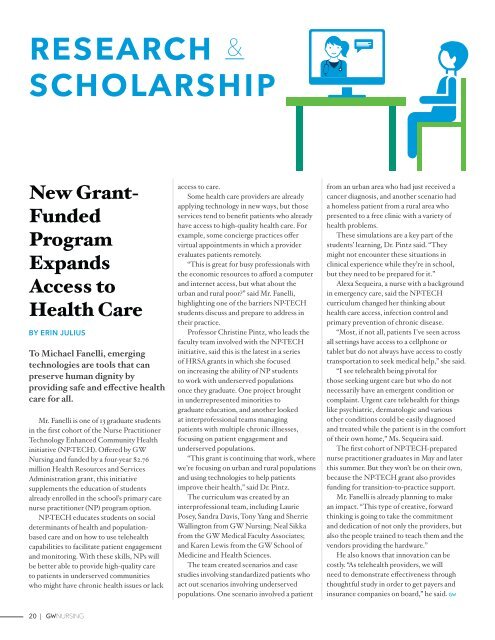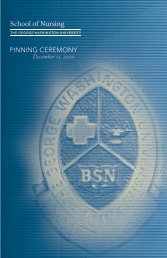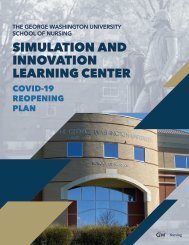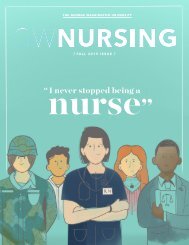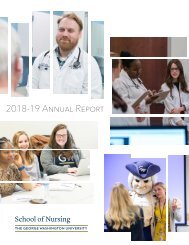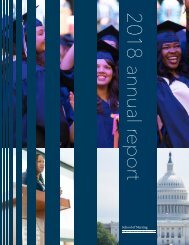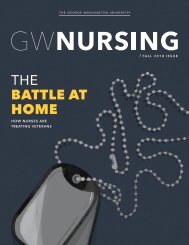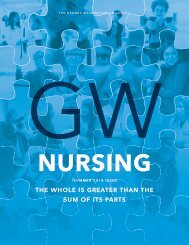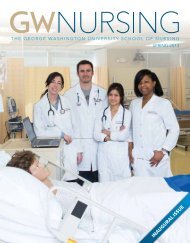GW Nursing Magazine Spring 2020
GW Nursing is a publication of the George Washington University School of Nursing. The magazine tells the story of GW nurses and their endeavors in the areas of education, research, policy and practice.
GW Nursing is a publication of the George Washington University School of Nursing. The magazine tells the story of GW nurses and their endeavors in the areas of education, research, policy and practice.
You also want an ePaper? Increase the reach of your titles
YUMPU automatically turns print PDFs into web optimized ePapers that Google loves.
esearch &<br />
scholarship<br />
New Grant-<br />
Funded<br />
Program<br />
Expands<br />
Access to<br />
Health Care<br />
BY ERIN JULIUS<br />
To Michael Fanelli, emerging<br />
technologies are tools that can<br />
preserve human dignity by<br />
providing safe and effective health<br />
care for all.<br />
Mr. Fanelli is one of 13 graduate students<br />
in the first cohort of the Nurse Practitioner<br />
Technology Enhanced Community Health<br />
initiative (NP-TECH). Offered by <strong>GW</strong><br />
<strong>Nursing</strong> and funded by a four-year $2.76<br />
million Health Resources and Services<br />
Administration grant, this initiative<br />
supplements the education of students<br />
already enrolled in the school’s primary care<br />
nurse practitioner (NP) program option.<br />
NP-TECH educates students on social<br />
determinants of health and populationbased<br />
care and on how to use telehealth<br />
capabilities to facilitate patient engagement<br />
and monitoring. With these skills, NPs will<br />
be better able to provide high-quality care<br />
to patients in underserved communities<br />
who might have chronic health issues or lack<br />
access to care.<br />
Some health care providers are already<br />
applying technology in new ways, but those<br />
services tend to benefit patients who already<br />
have access to high-quality health care. For<br />
example, some concierge practices offer<br />
virtual appointments in which a provider<br />
evaluates patients remotely.<br />
“This is great for busy professionals with<br />
the economic resources to afford a computer<br />
and internet access, but what about the<br />
urban and rural poor?” said Mr. Fanelli,<br />
highlighting one of the barriers NP-TECH<br />
students discuss and prepare to address in<br />
their practice.<br />
Professor Christine Pintz, who leads the<br />
faculty team involved with the NP-TECH<br />
initiative, said this is the latest in a series<br />
of HRSA grants in which she focused<br />
on increasing the ability of NP students<br />
to work with underserved populations<br />
once they graduate. One project brought<br />
in underrepresented minorities to<br />
graduate education, and another looked<br />
at interprofessional teams managing<br />
patients with multiple chronic illnesses,<br />
focusing on patient engagement and<br />
underserved populations.<br />
“This grant is continuing that work, where<br />
we’re focusing on urban and rural populations<br />
and using technologies to help patients<br />
improve their health,” said Dr. Pintz.<br />
The curriculum was created by an<br />
interprofessional team, including Laurie<br />
Posey, Sandra Davis, Tony Yang and Sherrie<br />
Wallington from <strong>GW</strong> <strong>Nursing</strong>; Neal Sikka<br />
from the <strong>GW</strong> Medical Faculty Associates;<br />
and Karen Lewis from the <strong>GW</strong> School of<br />
Medicine and Health Sciences.<br />
The team created scenarios and case<br />
studies involving standardized patients who<br />
act out scenarios involving underserved<br />
populations. One scenario involved a patient<br />
from an urban area who had just received a<br />
cancer diagnosis, and another scenario had<br />
a homeless patient from a rural area who<br />
presented to a free clinic with a variety of<br />
health problems.<br />
These simulations are a key part of the<br />
students’ learning, Dr. Pintz said. “They<br />
might not encounter these situations in<br />
clinical experience while they’re in school,<br />
but they need to be prepared for it.”<br />
Alexa Sequeira, a nurse with a background<br />
in emergency care, said the NP-TECH<br />
curriculum changed her thinking about<br />
health care access, infection control and<br />
primary prevention of chronic disease.<br />
“Most, if not all, patients I've seen across<br />
all settings have access to a cellphone or<br />
tablet but do not always have access to costly<br />
transportation to seek medical help,” she said.<br />
“I see telehealth being pivotal for<br />
those seeking urgent care but who do not<br />
necessarily have an emergent condition or<br />
complaint. Urgent care telehealth for things<br />
like psychiatric, dermatologic and various<br />
other conditions could be easily diagnosed<br />
and treated while the patient is in the comfort<br />
of their own home,” Ms. Sequeira said.<br />
The first cohort of NP-TECH-prepared<br />
nurse practitioner graduates in May and later<br />
this summer. But they won’t be on their own,<br />
because the NP-TECH grant also provides<br />
funding for transition-to-practice support.<br />
Mr. Fanelli is already planning to make<br />
an impact. “This type of creative, forward<br />
thinking is going to take the commitment<br />
and dedication of not only the providers, but<br />
also the people trained to teach them and the<br />
vendors providing the hardware.”<br />
He also knows that innovation can be<br />
costly. “As telehealth providers, we will<br />
need to demonstrate effectiveness through<br />
thoughtful study in order to get payers and<br />
insurance companies on board,” he said.<br />
20 |


